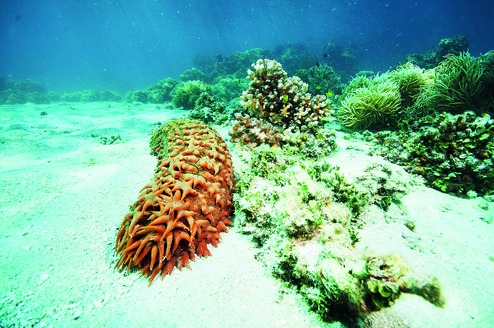
Anyone who’s ever browsed a menu card at an upscale seafood joint or strolled the food streets in Shanghai, Hong Kong or Tokyo has definitely encountered the haishen, or sea cucumber. A close cousin of sea urchins and starfish, these oblong, slow-moving invertebrates arguably top the list of Chinese and east Asian cuisine.
These marine organisms have been savoured in Asia for centuries. Once reserved for the wealthy, they were prized for their mythical medicinal properties and touted as aphrodisiacs and antidotes against ageing. In recent times, China’s economic boom has meant more people can afford this delicacy, fuelling skyrocketing demand in the international black market.

The past few decades has also seen it being scientifically proven that sea cucumbers — mostly as the processed dry product called beche-de-mer in the West — pack more protein than any other food. It’s also loaded with nutritional supplements and is low in fat.
No wonder then that wild sea cucumber populations across the world have plummeted, forcing poachers to adopt ever more aggressive methods of harvesting these docile animals.
While global outrage over the slaughter of sharks for fin soup may have helped stop their over-exploitation, no such outcry has been raised on behalf of the humble sea cucumber. These faceless, beneficial creatures are now in trouble and so are the coral reefs that usually house them. Sea cucumbers are critical to marine ecosystems, cleaning the sea floor of waste materials from other organisms and recycling them into nutrients creatures can use. Plus, their alkaline poop buffers coral reefs against the corrosive effects of ocean acidification.
Marine ecologist Andreas Kunzmann at the Leibniz Centre for Tropical Marine Ecology in Bremen, Germany, first came across these good samaritans of the ocean floor while investigating why corals are dying worldwide, especially at the Great Barrier Reef. Kunzmann has seen how sea cucumbers in the coral reefs play a key role in the survival of these magnificent organisms. One of the by-products of the sea cucumber’s digestion of sand is calcium carbonate, an important component of coral. He told Knowhow, “They play a key role in marine ecosystems through bioturbation [restructuring of sedimentary deposits], burrowing and feeding on organic matter in marine sediments. Their over-exploitation has dire consequences for tropical seas and oceans.”

Kunzmann and his co-researchers realised that the best way to revive these creatures would be integrated multi-trophic aquaculture — in other words, farming — and developing the right food to aid survival.
In the large aquariums of ZMT they started rearing and studying the feeding preferences of deep-sea cucumbers, particularly Holothuria scabra. One of the researchers happens to be Calcutta lad Kunal Mondal, who has earlier worked with marine creatures in the Sunderban. The post-doctoral fellow says, “My research involves developing a nutritious diet.” According to him, the Ecophysiology group at ZMT is focussed on scientific monitoring of tropical marine ecosystems, including research on unique aquaculture, to solve future food shortage.
While Mondal may now be working on rearing sea cucumbers in Germany, it was in India that the seeds needed for such farming were first collected. Scientists at the Central Marine Fisheries Research Institute (CMFRI) at Kochi in India pioneered the novel techniques, including commercial seed production, to farm the most valuable sea cucumber Holothuria scabra. Harvesting sea cucumbers — both farmed and from the wild — was, however, banned in India in 2001 under the Indian Wildlife Protection Act, 1972. The seas around Andaman and Nicobar Islands, Lakshadweep and the Gulf of Mannar are natural habitats of these creatures.
In the last few years, the CMFRI technique of sea ranching has been used in many east Asian sea cucumber farms. “Farming of sea cucumbers in mesh pens has turned into an important source of livelihood for many fishing communities, such as those in Madagascar and Phillipines,” says Mondal.
Farming these marine creatures has indeed turned into a lucrative business as biomedical researchers are discovering them to be a rich source of anti-oxidants, carotenoids and collagen, which can fight age-related bone disorders and even cancer.
So amid the gloom-and-doom story of oceans being stripped to satisfy the appetite of the nouveau rich in east Asia, there is a glimmer of hope for both sea cucumbers and impoverished fishing communities.











